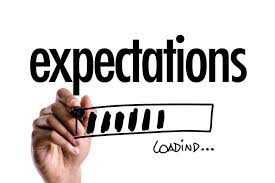JUN 2025, Vol 22, Issue 6
Overview
- Communicating Values and Expectations
- Recent Grads Unprepared
- Employee Feedback
Communicating Values and Expectations
Effective businesses and leaders don't just wait and hope for employees and others to align with organizational values and meet their expectations. They recognize it takes work and constant reinforcement. So, effective communication doesn't end when a message is delivered. It is a continuous process that involves two-way communication and continuous monitoring to make sure everyone is on track.
There are a number of ways that managers can communicate their expectations to employees, vendors, and others with whom they do business. For change to happen and stick, all businesses must commit to improving people's understanding of what, why, how, when and who of changes, and make sure that employees have access to change communication and understand the change information they're given.
There is a need to use effective communication methods and keep these pointers top of mind. One: communicate, it's important to include all employees so they are in the loop about the actual situation. It gives them an opportunity to communicate and ask questions. Two: collaborate, if there are any actions that employees can take to remedy this situation, tell them what they can do. The transition will go smoother if they can be involved in the decisions that affect them. Three: connect, when talking to employees, be honest, truthful, and don't hide the facts.
In today's volatile business environment, businesses must ensure they're effective at communication and utilizing as many methods as possible to reach the employees. Communication is at the core of change. If employees are to embrace and commit to the change, the message is as important as the method.
Here are twelve of the most effective communication methods for change in businesses that can be used together or independently: change communication infographic; focus group; face-to-face announcement; intranet website dedicated to change information; one-on-one discussion; panel discussion; question-and-answer session; roadshow; town hall presentation; team meeting; video, webcast, and continuous e-mail updates; and workshop.
Knowing and using these communication methods will help businesses and employees to understand change and think differently about how to partake meaningfully to ensure that the change sticks. Make sure the employees are aware of the detail of the change and to recognize the transparency surrounding it. Increase employees' awareness of the wide range of information and understanding on how they can change to enable more positive outcomes.
- - - -
Recent Grads Unprepared
Over half of hiring managers say recent grads are unprepared for the workforce and their top complaints included excessive phone usage, a lack of professionalism and poor time management skills.
Colleges don’t teach students how to behave in the workplace. Most students graduate with little exposure to professional environments, so when they arrive at their first job employers need to teach them about basic workplace norms.
We suggest that you incorporate an overview of expectations into their onboarding that should include taking initiative, positive attitude, strong work ethic, adaptability, openness to feedback, cell phone rules, dress code, personal appearance and image, punctuality and strong interpersonal skills.
- - - -
Employee Feedback
Employee feedback is a powerful way to influence employees and make sure everyone is doing what is expected of them. In general, communication should be bidirectional, in addition to telling employees what to do, they should also be given the opportunity to offer suggestions on how they can help do their work. But to reap the most benefit, feedback must be done right. Otherwise, few results is yielded while taking a tremendous amount of time.
Most people think that giving positive feedback is simple. However, providing meaningful, productive feedback that will resonate with the employees and reinforce their positive behavior will take some work to help employees learn and grow from positive feedback. These elements should be included in the feedback message, make feedback more impactful and powerfully frame employees accomplishments in a bigger context. Explain the impact of their achievement on others, such as colleagues and customers, and make it links to the business's bottom line.
Body language. Pay attention to the body language when delivering positive feedback. The way things are said is just as important as what is being said. Make sure to smile and keep eye contact and use appropriate facial and hand expressions. Meaningful gestures to make positive feedback are even more powerful. It should be amplified with a meaningful gesture. Think of a way to make feedback special and celebrate employee success. Perhaps go for a walk in a nearby park. Grab a coffee or a box of candies and celebrate.
Personalized feedback should be tailored to the employee's preference. For example, some employees feel great when they recognize in public, while others may not get to know the employees and their preferences on the right specific. Gallup has found that employees are more likely to learn and grow when they receive immediate feedback that is specific. Avoid giving the vague praise and communicate exactly what the employee did and what was commendable. Feedback should be crystal clear and to the point. Be genuine, don't praise employees just for the sake of it, and give feedback to employees when there's a concrete reason. Be honest and direct.
Be timely, don't wait for a scheduled meeting or performance review to give employees positive feedback. Waiting to recognize employees can leave them feeling as though their hard work has gone unnoticed. Focus on effort, the focus should be on the employees effort and behavior what they do rather than their personality traits or talents. What they're like. This encourages a growth mindset in employees and will help them build determination and resilience. Giving positive feedback helps employees recognize and hone their skills, develop their areas of improvement, and create a general sense of positivity in the workplace. Here are some feedback tools:
Interviews: the advantage of these is that they provide "rich" information that includes specific illustrations about important issues and emotional feelings associated with them. The disadvantage of interviews is that they're very time consuming and may produce conclusions that are not representative of the entire work group.
Engagement surveys measure the degree to which employees feel valued at work. It helps determine whether employees are happy and how long they'll stay with the business.
Individual employee's sessions are a great opportunity to connect with an employee on a personal level. A best practice for these meetings is to always allow the employee to speak first.
Informal interview is an oral interview that may take place anywhere. It can be for a variety of reasons such as clarifying goals, gain an understanding of expectations to receive feedback on ways to improve individual performance, and to discuss personal needs.
Exit interview is a meeting with the employee prior to leaving the team or business. It gives an opportunity for the employee to provide their opinions, views, and feelings on the job and the business. It helps to develop and improve policies for deficiencies that are uncovered.
Employee group sessions involve small groups of employees participating in facilitated discussions. They're often used to improve employee engagement.
Skip level or executive meetings are facilitated by a senior-level manager with an employee, or a group of employees, within the same business unit. They're used to address employee concerns, build relationships, or to support retention efforts.
Employee focus groups is a small group participating of usually unrelated employees in a structured discussion with a facilitator. They provide qualitative data on specific issues and can be used in conjunction with or independent of a survey. They can provide in-depth feedback on specific issues.
- - - -
Contact HR Strategies at 302.376.8595 or info@hrstrategies.org if you would like support or would like to learn more about the items in this newsletter. Please contact us if you would like to be added to our Monthly Strategies mailing list or if you would like for us to add someone to our mailing list.


